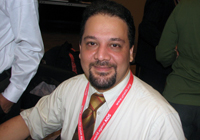 Hamid Reza Setayesh is UNAIDS Country
Hamid Reza Setayesh is UNAIDS Country
Coordinator in Iran.HamidReza Setayesh became the UNAIDS Country Coordinator (UCC) when the UNAIDS Iran office was established in March 2005. Like most UNAIDS Country Coordinators Setayesh’s time is filled with the major task of coordinating the UN response on AIDS in the country. In Iran there are 13 UN offices that make up the Joint UN Team on AIDS, which he chairs. In addition to this, the UNAIDS office also provides technical support to the government and non-governmental organizations (NGOs) as it is considered a trusted and reliable partner.
“Our greatest achievement has been the harmonisation of the UN response to AIDS,” says Setayesh. “We were able to move forward and I am very satisfied with that.” Other important achievements in his three years of office are in the area of improving strategic information, where the country lacks sufficient capability. UNAIDS has assisted the government in designing small studies which provide the evidence for successful interventions.
The major factor which is fuelling the epidemic in Iran is the use of contaminated injecting equipment among injecting drug users, as well as sexual transmission of the disease. Therefore, the work of the Joint UN Team on AIDS is primarily focused on the issue of injecting drug use, “It is our top priority to advocate with the government to allocate resources towards harm reduction interventions,” says Setayesh. According to the United Nations Office on Drugs and Crime (UNODC), there are an estimated 200,000 injecting drug users in the country, considerable proportion of whom are using crystal-base heroin which is known in the market as “crack”.
This work has been successful and the Iranian government has one of the most progressive harm reduction policies on record in a developing country. There are more than 20,000 drug users on the government methadone maintenance programme, which began three years ago. Important legal reforms have facilitated the success of this programme: although drug use is a crime, people who are having treatment for drug use are not considered criminals. “Even needle and syringe programmes can be considered treatment, which is a very big achievement and an important step to de-stigmatise and make services available to people who inject drugs,” says Setayesh. Based on the most recent available studies, more than 90 percent of drug users have used clean needles for their last injection in Tehran.
Two years ago the drug treatment programme was extended to prisons where the United Nations Office on Drugs and Crime (UNODC) is the main partner. “A lot has been done but there is room for improvement,” says Setayesh. “Prison systems are trying to introduce needle exchange and condoms, but it is a challenge to encourage the prisoners to use them. This requires reform to expand services in prisons. “
Nonetheless, Iran is moving from having a concentrated HIV epidemic among injecting drug users to a more generalized situation, mainly affecting partners and wives of people who inject drugs and people formerly in prison. Although the response among these particular key populations has been remarkable and progressive, other groups who engage in risky behaviour such as sex workers and men who have sex with men are not sufficiently addressed in the country's response. Homosexuality is a sensitive issue in Iran and providing services for men who have sex with men presents many challenges for UNAIDS, which is the leading UN programme in this area.
As in many other countries, it is stigma that is the major obstacle to the AIDS response in Iran. “This is found at different levels,” says Setayesh, “although we get a lot of support from communities, from government and partners, it is still a challenge.”
There is also difficulty in getting funding for innovative ideas to challenge stigma. “Though the government is committed, they spend a lot of money on methadone substitution and harm reduction. When you want to work with other groups, the government is less interested and there is no donor support,” says Setayesh. “Radio and television are not that interested in openly addressing stigma, particularly with regard to sexual transmission. They are much better with drugs.”
The Joint UN Team has worked on identifying major sources of stigma and on a novel approach to combat it. They approached high level religious leaders who supported the principle that people living with HIV should not be discriminated against and that public funds should be allocated for their health care. “This helped people living with HIV to express themselves and has put a face to HIV.” In addition, a new strategy, “Positive Prevention” is being developed by National AIDS Programme through supports from UNAIDS and UNDP.
Setayesh is upbeat about the prospects for Iran’s AIDS response. “I think everything is possible in this country,” he says. “It’s very progressive in many aspects, and the government’s work is based on evidence. That provides a very good opportunity for us to convince policy-makers to do more for public health.” With these attitudes Setayesh believes it may be possible to turn the epidemic around. There is already evidence that the methadone substitution programme is having an impact, with decreased prevalence in prisons. “We hope to see results in two years time,” he says. “And that will remarkably affect the community outside because of the linkages between drugs and sex work. So this is a golden opportunity that has already been used and I hope continues.”




